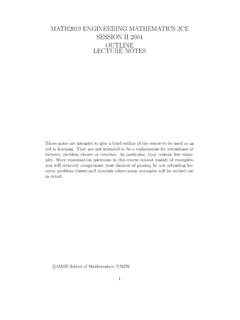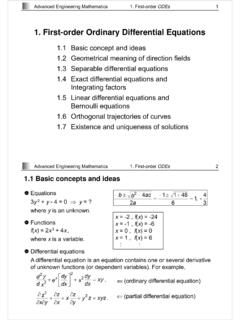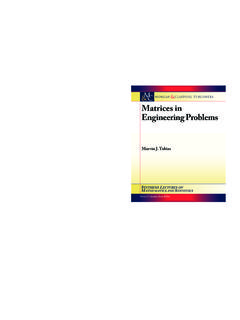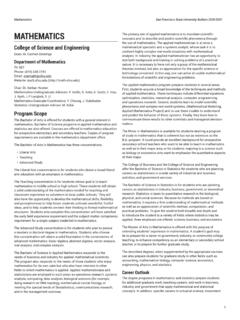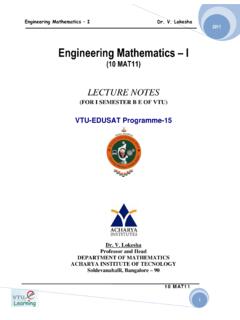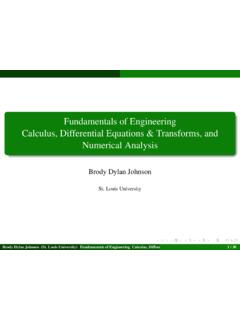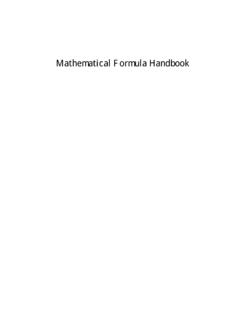Transcription of Calculus This is the free digital calculus text by David R ...
1 CalculusThis work is licensed under the Creative Commons Attribution-NonCommercial-ShareAlike License. Toview a copy of this license, send a letter toCreative Commons, 543 Howard Street, 5th Floor, San Francisco, California, 94105, USA. If you distributethis work or a derivative, include the history of the text was initially written by David Guichard. The single variable material (not including infiniteseries) was originally a modification and expansion of notes written by Neal Koblitz at the Universityof Washington, who generously gave permission to use, modify, and distribute his work. New materialhas been added, and old material has been modified, so some portions now bear little resemblance to book includes some exercises fromElementary Calculus : An Approach Using Infinitesimals, byH.
2 Jerome Keisler, available ~ a Creative Com-mons license. Albert Schueller, Barry Balof, and Mike Wills have contributed additional copy of the text was produced at 16:02 on 5/31 will be glad to receive corrections and suggestions for improvement .. Between Two Points; Circles .. and Dilations ..142 Instantaneous Rate Of Change: The slope of a function .. example .. Derivative Function .. For Functions ..40vviContents3 Rules For Finding Power Rule .. of the Derivative .. Product Rule .. Quotient Rule .. Chain Rule ..564 Transcendental Functions .. Derivative of sinx.. hard limit .. Derivative of sinx, continued .. of the Trigonometric Functions.
3 And Logarithmic functions .. of the exponential and logarithmic functions .. revisited .. Differentiation .. Trigonometric Functions ..895 Curve and Minima .. first derivative test .. second derivative test .. and inflection points .. and Other Things to Look For ..102 Contentsvii6 Applications of the .. Rates .. s Method .. Approximations .. Mean Value Theorem .. examples .. Fundamental Theorem of Calculus .. Properties of Integrals ..1508 Techniques of .. of sine and cosine .. Substitutions .. by Parts .. Functions .. exercises ..176viiiContents9 Applications of between curves .. , Velocity, Acceleration .. value of a function .. of Mass.
4 Energy; improper integrals .. Length .. Area .. equations ..22710 Sequences and .. Integral Test .. Series .. Tests .. Convergence .. Ratio and Root Tests .. Series .. with Power Series .. Series .. s Theorem .. exercises ..271 ContentsixAIntroduction to Started .. and Expressions .. and Substitution .. Equations .. Differentiation .. text to a Maple session .. your work .. Help ..287 BSelected Answers289 Index303 IntroductionThe emphasis in this course is on problems doing calculations and story problems. Tomaster problem solving one needs a tremendous amount of practice doing problems. Themore problems you do the better you will be at doing them, as patterns will start to emergein both the problems and in successful approaches to them.
5 You will learn fastest and bestif you devote some time to doing problems every the most difficult problems are story problems, since they require some effortbefore you can begin calculating. Here are some pointers for doing story read each problem twice before writing letters to quantities that are described only in words; draw a diagram which letters are constants and which are variables. A letter stands for aconstant if its value remains the same throughout the mathematical notation, write down what you know and then write downwhat you want to what category of problem it is (this might be obvious if the problem comesat the end of a particular chapter, but will not necessarily be so obvious if it comeson an exam covering several chapters).
6 Check each step as you go along; don t wait until the end to check common sense; if an answer is out of the range of practical possibilities, thencheck your work to see where you went for Using This the example problems carefully, filling in any steps that are left out (asksomeone if you can t follow the solution to a worked example). use the worked examples to study by covering the solutions, and seeing ifyou can solve the problems on your exercises have answers in AppendixB; the availability of an answer is markedby at the end of the exercise. In the pdf version of the full text, clickingon the arrow will take you to the answer. The answers should be used only asa final check on your work, not as a crutch.
7 Keep in mind that sometimes ananswer could be expressed in various ways that are algebraically equivalent, sodon t assume that your answer is wrong just because it doesn t have exactly thesame form as the answer in the few figures in the book are marked with (JA) at the end of the on this should open a related Java applet in your web Useful FormulasAlgebraRemember that the common algebraic operations haveprecedencesrelative to eachother: for example, mulitplication and division take precedence over addition andsubtraction, but are tied with each other. In the case of ties, work left to right. Thismeans, for example, that 1/2xmeans (1/2)x: do the division, then the multiplicationin left to right order.
8 It sometimes is a good idea to use more parentheses than strictlynecessary, for clarity, but it is also a bad idea to use too many the square:x2+bx+c= (x+b2)2 b24+ formula: the roots ofax2+bx+care b b2 rules:ab ac=ab+cabac=ab c(ab)c=abca1/b=b aIntroductionxiiiGeometryCircle: circumference = 2 r, area = : vol = 4 r3/3, surface area = 4 : vol = r2h, lateral area = 2 rh, total surface area = 2 rh+ 2 : vol = r2h/3, lateral area = r r2+h2, total surface area = r r2+h2+ geometryPoint-slope formula for straight line through the point (x0, y0) with slopem:y=y0+m(x x0).Circle with radiusrcentered at (h, k): (x h)2+ (y k)2= with axes on thex-axis andy-axis:x2a2+y2b2= ( ) = opposite/hypotenusecos( ) = adjacent/hypotenusetan( ) = opposite/adjacentsec( ) = 1/cos( )csc( ) = 1/sin( )cot( ) = 1/tan( )tan( ) = sin( )/cos( )cot( ) = cos( )/sin( )sin( ) = cos( 2 )cos( ) = sin( 2 )sin( + ) = sin( )cos( + ) = cos( )Law of cosines:a2=b2+c2 2bccosALaw of sines:asinA=bsinB=csinCxivIntroductionSi ne of sum of angles: sin(x+y) = sinxcosy+ cosxsinysin2( ) and cos2( ) formulas:sin2( ) + cos2( ) = 1sin2( ) =1 cos(2 )2cos2( ) =1 + cos(2 )2 Cosine of sum of angles: cos(x+y) = cosxcosy sinxsinyTangent of sum of angles.
9 Tan(x+y) =tanx+ tany1 tanxtany1 Analytic GeometryMuch of the mathematics in this chapter will be review for you. However, the exampleswill be oriented toward applications and so will take some the (x, y) coordinate system we normally write thex-axis horizontally, with positivenumbers to the right of the origin, and they-axis vertically, with positive numbers abovethe origin. That is, unless stated otherwise, we take rightward to be the positivex-direction and upward to be the positivey-direction. In a purely mathematical situation,we normally choose the same scale for thex- andy-axes. For example, the line joining theorigin to the point (a, a) makes an angle of 45 with thex-axis (and also with they-axis).
10 But in applications, often letters other thanxandyare used, and often different scalesare chosen in thexandydirections. For example, suppose you drop something from awindow, and you want to study how its height above the ground changes from second tosecond. It is natural to let the lettertdenote the time (the number of seconds since theobject was released) and to let the letterhdenote the height. For eacht(say, at one-secondintervals) you have a corresponding heighth. This information can be tabulated, and thenplotted on the (t, h) coordinate plane, as shown in use the word quadrant for each of the four regions the plane is divided into: thefirst quadrant is where points have both coordinates positive, or the northeast portionof the plot, and the second, third, and fourth quadrants are counted off counterclockwise,so the second quadrant is the northwest, the third is the southwest, and the fourth is 1 Analytic Figure data we have two pointsA(2,1) andB(3,3) in the (x, y)-plane.
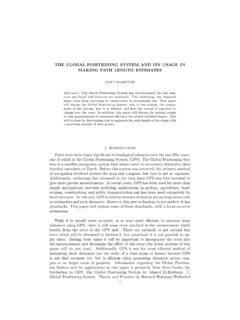
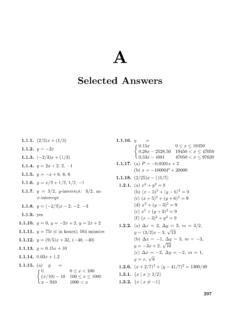
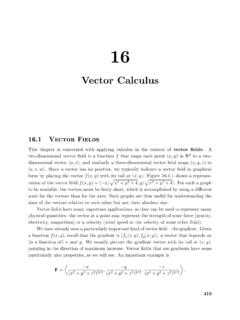
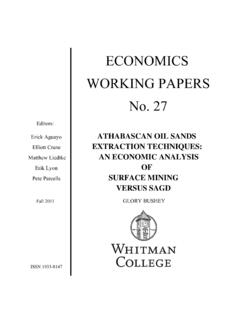
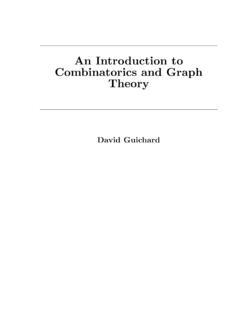
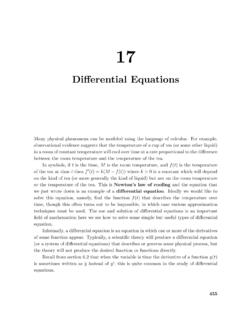
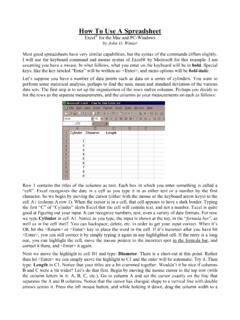

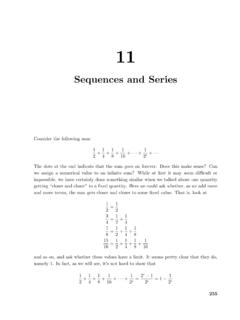
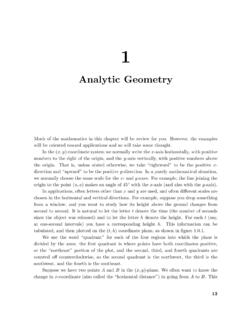
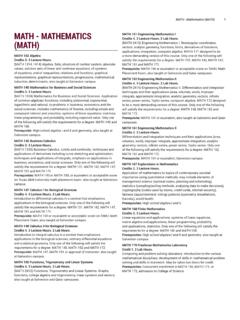
![[Engineering Mathematics]](/cache/preview/1/e/f/3/d/f/5/2/thumb-1ef3df52d76a8c1d51851076ed688d22.jpg)
